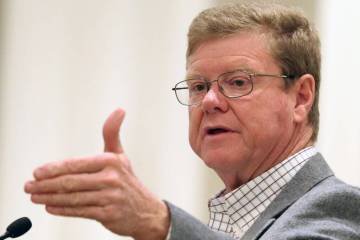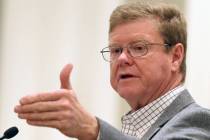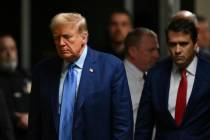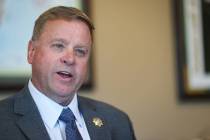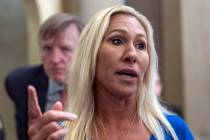Trump launches push for tax overhaul to boost middle class
WASHINGTON — President Donald Trump pitched his new tax-reform initiative Wednesday in a speech that promised to boost the middle class by challenging a rigged system.
Speaking at a manufacturing company in Springfield, Missouri, Trump provided few specifics of what the tax plan should look like. Treasury Secretary Steve Mnuchin and chief economic adviser Gary Cohn have been talking with GOP congressional leaders, but the push to sell the tax-reform plan precedes a plan itself.
Trump told the crowd the White House chose Springfield for the address because it is considered the birthplace of the legendary Route 66, “where the Main Street of America got its start.”
“For many decades, Route 66 captured the American spirit” as truck drivers hauled made-in-America goods and manufacturing “gave Americans a paycheck that could support a family,” Trump said. But over time, for many families, that prosperity slipped away “in the rearview mirror,” he said.
A White House official told reporters during a background briefing Tuesday that Trump would focus on why America needs tax reform — with an emphasis on “ending the rigged system in closing these special interest loopholes that have only benefited the wealthy and powerful few.” In his remarks at the Loren Cook Co., a manufacturer of fans and ventilation systems, Trump repeatedly assailed loopholes that benefit the wealthy, but he did not use the word “rigged.”
The Springfield event was closed to the public. White House officials said they had determined it was more appropriate to announce the policy drive at a manufacturing setting, and not in a rally-type setting.
It turned out the less-boisterous atmosphere was fitting as Fox News and MSNBC broadcast the speech on split screens that also showed rescue efforts in flooded buildings and streets where Tropical Storm Harvey deluged parts of the Gulf Coast. It was the rare moment when Trump was not the big story.
The president began his address with a nod to “the deeply tragic situation in Texas and Louisiana” and a salute to the small miracles and their makers in the midst of the epic storm.
“We see friend helping friend, neighbor helping neighbor, and stranger helping stranger,” Trump said. “And together, we will endure and we will overcome.”
Wednesday dawned with good economic news. American businesses added 237,000 jobs in August, payroll firm Automatic Data Processing reported. The Commerce Department revised its estimate for the second quarter’s growth in gross domestic product to an annualized rate of 3 percent. It was the best showing since a 3.2 percent gain in the first quarter of 2015.
“We just announced that we hit 3 percent in GDP,” Trump crowed. “It just came out. And on a yearly basis, as you know, the last administration during an eight-year period never hit 3 percent. So we’re really on our way.”
It was the economy’s failure to maintain 3 percent growth under President Barack Obama that haunted an economic recovery that never quite graduated from anemic to robust.
Trump added, “And I happen to be one that thinks we can go much higher than 3 percent. There’s no reason why we shouldn’t.”
The administration’s set of goals
While the Springfield speech marked the beginning of Trump’s effort to pass a large tax-reform package, it was not his first word on the topic. In April, the White House released a one-page document, “2017 Tax Reform for Economic Growth and American Jobs,” which serves as a map for the administration’s goals.
The paper called for a 15 percent corporate tax rate that would be funded in part by eliminating loopholes, a collapse of income tax brackets from seven to three brackets of 10 percent, 15 percent and 35 percent, and a doubling of the standard deduction and increase in the child care deduction.
Trump argued that Washington has to reduce America’s 35 percent corporate tax rate — “the highest rate in the developed world,” according to Scott Greenberg of the right-leaning Tax Foundation — to compete with other nations in the unending international competition to attract jobs.
While Trump advocated for a 15 percent rate, Greenberg’s guess is that if Congress passes a bill, its corporate rate would be closer to 25 percent.
GOP communications strategist Kevin Madden said he’s not concerned about the lack of specifics from Trump. “There’s a reason why constitutionally all tax bills have to begin in the House,” he said. “It’s really up to the lawmakers anyway.”
Besides, he added, Republicans feel the pressure to deliver on this key campaign promise.
“We are united in our determination to get this done,” House Speaker Paul Ryan said in a statement.
Democrats ready for a fight
On a conference call, Senate Minority Leader Chuck Schumer, D-N.Y., told reporters that tax reform will be “one of the biggest fights of the next three, four months, and Democrats are ready for it.”
Rep. Dina Titus, D-Nev., said in a statement, “The president’s so-called tax reform plan, which is full of vague promises, rigs the system to benefit the wealthy. We should know by now that ‘trickle down’ economics is a myth which allows the rich to get richer while causing middle-class families to fall further behind.”
“Here’s the problem,” said Chuck Marr, director of Federal Tax Policy of the left-leaning Center on Budget and Policy Priorities. “Trump, he ran a campaign trying in part to appeal to the economic interest of working-class people. And his tax proposals do nothing for working-class people.”
Low-income workers would do better, Marr argued, if Trump expanded the Earned Income Tax Credit.
Because Senate rules require 60 votes to pass a measure that adds to the federal deficit, Republicans are looking to close loopholes in order to present a bill that a simple majority can pass. “Tackle all of them at once and then use all of them for a big rate cut so that no one is too disproportionately hurt,” Greenberg said.
Republicans understand that if the GOP cannot deliver tax reform while the party controls the White House, Senate and House that would speak volumes about the party’s ability to get things done.
“They say they need to do it. The media says they need to do it,” said Henry Olson, author of “The Working Class Republican: Ronald Reagan and the Return of Blue-Collar Conservatism.” “They’re both right.”
Contact Debra J. Saunders at dsaunders@reviewjournal.com or 202-662-7391. Follow @DebraJSaunders on Twitter.







